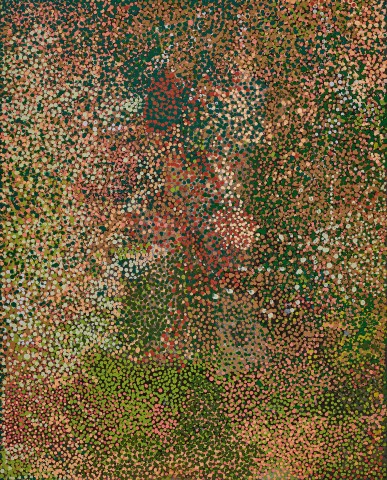OF RARE WINTER RAIN, 1990
EMILY KAME KNGWARREYE
synthetic polymer paint on linen
151.0 x 121.0 cm
bears inscription verso: artist’s name and Delmore Gallery cat. 0P03
Commissioned by Delmore Gallery, via Alice Springs
Chapman Gallery, Canberra
Private collection, New South Wales, acquired from the above in 1990
The Singing Earth, Chapman Gallery, Canberra, 28 November – 23 December 1990, cat. 23
Grishin, S., ‘Brilliant paintings from deserts’, Canberra Times, 1 December 1990, p. 23
This painting is accompanied by a certificate of authenticity from Delmore Gallery, via Alice Springs
In his review of the 1990 exhibition, The Singing Earth, at Chapman Gallery in Canberra, Sasha Grishin highlights Of Rare Winter Rain, 1990, observing that, ‘Emily Kngwarreye’s haunting and mysterious creation (is a work) to which one is constantly drawn back, as if by a magnetic presence’.1 As with much of her painting, this vibrant and colourful work struck a chord with almost all who saw it, a portent perhaps of the global clamour for her art, yet to come, which confirmed Kngwarreye as undoubtedly one of Australia’s greatest painters of the twentieth century.
Kngwarreye’s individual response in acrylic paint to the everchanging landscape of her traditional homelands at Alhalker (Alalgura) offers a record of her acute observations, often described in minute detail, of the shifting fluctuations of the flora and landscape that surrounded her. Her painting technique of covering the canvas with fluid dots or blobs of colour that formed pulsating layers, literally embodied her sense of the changing, yet ordered, rhythms of the natural world. Painted in November 1990, Of Rare Winter Rain records the effects of unseasonal winter storms on the landscape where, as Janet Holt notes in the accompanying certificate, ‘the transformation of the desert … has a different colour and mood than that of the more frequent summer rains, here the colours are more sombre, recalling verdant greens and misty dawns over frosted grasses and wild flowers’.2
‘Clearly Emily Kngwarreye was a mark-maker extraordinaire … she ventured further with masses of dots and marks, making intimate and grand gestures layering and intensifying the dots to the exclusion of graphic elements.’3 And here, the layered dots of pink, olive, green, purple, blue and grey, in many places applied by the artist using her fingers, faithfully evoke the colour and mood of her country.
Emily Kame Kngwarreye’s wellspring came from a lifetime of making art, her paintings manifesting deep affinity to country and profound devotion to women’s ceremony in song, dance and the ceremonial painting of bodies. To Kngwarreye, it was all one, the differing elements merged together and she was immersed in the experience of painting and the interconnectedness of life, landscape and culture, connecting her back to country.
1. Grishin, S., ‘Brilliant paintings from deserts’, Canberra Times, Canberra, 1 December 1990, p. 23
2. From the accompanying Delmore Gallery certificate of authenticity
3. Ryan, J., in Isaacs, J. et al., Emily Kngwarreye Paintings, Craftsman House, Sydney, 1998, p. 77
CRISPIN GUTTERIDGE
